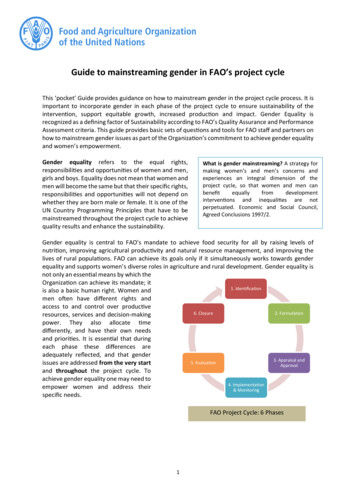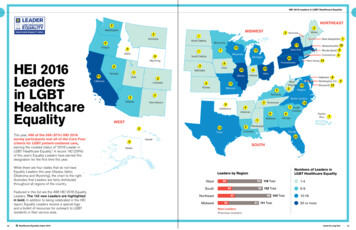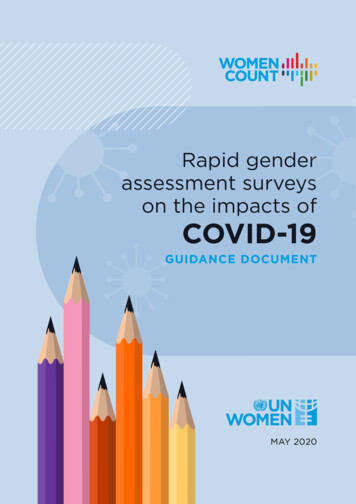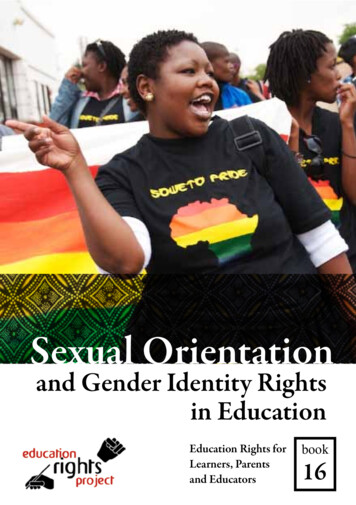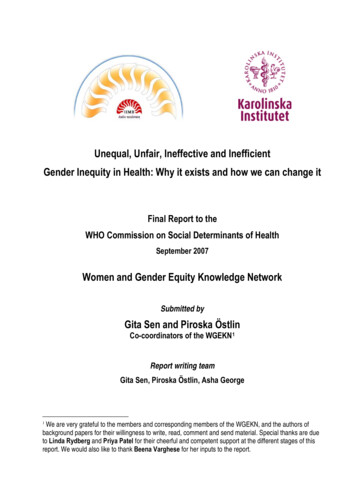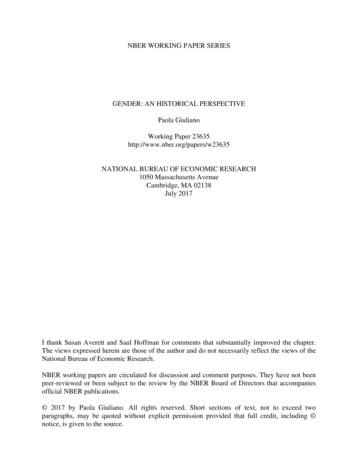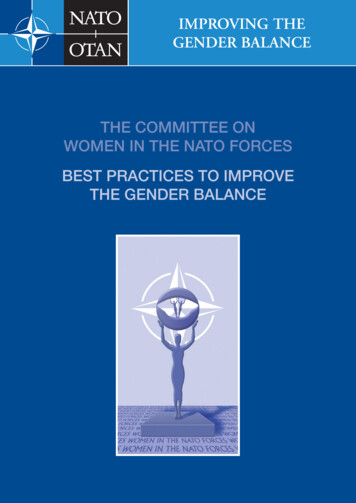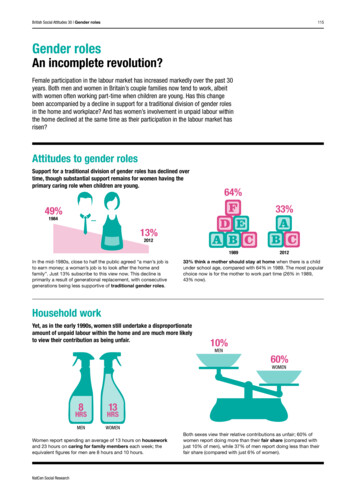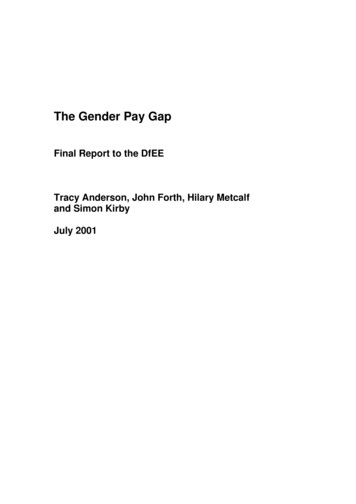
Transcription
GENDER EQUALITY TRAININGGender Mainstreaming Toolkit
This publication was prepared under the gender mainstreaming programme of the European Institute for Gender Equality.It is available online through EIGE’s Gender Mainstreaming Platform: http://eige.europa.eu/gender-mainstreamingThe European Institute for Gender Equality created the online Platform on Gender Mainstreaming to support the EUinstitutions and governmental bodies with the integration of a gender perspective in their work. The Platform providesinsights on the relevance of gender in a variety of policy areas and offers online tools for gender mainstreaming.The Platform helps to improve individual and institutional competences to mainstream gender into the different sectorialareas and throughout the different stages of the development of any policy/programme/project. Understanding how todesign, plan, implement, monitor and evaluate policies from a gender perspective will strengthen EU policies, increasingtheir societal relevance and responsiveness.
GENDER EQUALITY TRAININGGender Mainstreaming Toolkit
European Institute for Gender EqualityThe European Institute for Gender Equality (EIGE) is the EU knowledge centre on gender equality. EIGE supports policymakers and all relevant institutions in their efforts to make equality between women and men a reality for all Europeansby providing them with specific expertise and comparable and reliable data on gender equality in Europe.European Institute for Gender EqualityGedimino pr. 16LT-01103 VilniusLITHUANIATel. 370 52157444E-mail: erEurope Direct is a service to help you find answersto your questions about the European Union.Freephone number (*):00 800 6 7 8 9 10 11More information on the European Union is available on the Internet (http://europa.eu).Luxembourg: Publications Office of the European Union, 2016ISBN 978-92-9493-262-4doi:10.2839/915981 European Institute for Gender Equality, 2016Reproduction is authorised provided the source is acknowledged.
EIGEGender Mainstreaming Platform › Toolkits › Gender Equality TrainingContents1. Approach to gender equality training (GET).41.1 Introduction. 41.2 What is gender equality training?. 41.3 Basic terms and definitions . 51.4 Why invest in gender equality training?. 51.5 Who is the guide for?. 62. Guiding principles: a step-by-step guide for commissioning authorities on how toensure the quality of gender equality competence development initiatives.82.1 Planning phase: Preparing the ground for an effective gender equalitycompetence development initiative. 9Step 1.Assess the need for (regular) gender competence development initiatives in the organisation. 9Step 2.Integrate gender competence development initiatives into a broader strategy for gender equality. 9Step 3.Ensure that sufficient resources have been allocated to implement the initiativeand plan a follow-up strategy.10Step 4.Draft clear and relevant terms of reference (checklist).10Step 5.Select a trainer with competencies, skills and knowledge relevant to your organisation.112.2 Implementation phase: Setting up a gender equality competence developmentactivity that responds to the organisation’s needs and roles. 13Step 6.Engage in the gender-learning needs assessment.14Step 7. Actively participate in the design of the gender competence development initiative,keeping in mind the mandate of the organisation.14Step 8.Encourage people (including senior officials and managers) to attend the activity,tackling pre-training resistance within the organisation.15Step 9.Plan and implement a monitoring framework.152.3 Evaluation and follow-up phase: Securing long-term outcomes. 16Step 10. Set up an evaluation framework to measure the outcomes of the initiative at the individualand organisational levels.16Step 11. Assess the long-term impacts of training at the individual, organisational andsocietal levels.17Step 12. Give space and support to participants to implement new knowledge in their work.173. Gender equality training in practice . 183.1 Design effective gender equality training. 183.2 Find a gender trainer. 193.3 Gender equality training in the European Union. 194. References and resources. 22Gender Equality Training3
Gender Mainstreaming Platform › Toolkits › Gender Equality TrainingEIGE1. Approach to gender equalitytraining (GET)1.1 IntroductionThe ultimate goal of gender mainstreaming is advancinggender equality. Integrating gender concerns in policy decisions and their practical implementation is the responsibility of public authorities and institutions. Gender trainingmakes a difference. If implemented systematically it facilitates more efficient actions towards gender equality and apositive change in the attitudes of policymakers.Positive examples of institutional commitments to gendertraining exist in some EU Member States. However, EIGE’sresearch (1) shows that insufficient gender knowledge andskills is one of the main obstacles to a successful implementation of gender mainstreaming in the EU. Civil servants are more likely to consider gender aspects in theirwork if they are trained in this area and are convinced thatthis is important.This gender equality training tool is designed to stimulate investment in the gender equality skills of policymakers and public administration employees and to facilitatethe process of designing effective gender equality training. The guidelines provide a set of standards to commission effective gender equality training. Whereas previousstudies focus on the content of gender equality trainingor the profile of gender equality trainers, these guidelinesconsider the specific role and needs of commissioningauthorities at different stages of the gender competencedevelopment process.Commissioning authorities should be aware of the benefits of training activities, but be realistic about their limitstoo. The aim of gender equality training is not to transformparticipants into gender experts, but to make them moreaware of the relevance of gender in their work and tohelp them identify the appropriate tools to be used whenmainstreaming gender.1.2 What is genderequality training?Gender equality training (GET) provides participant(s) withthe relevant knowledge, skills and values that allow themto contribute to the effective implementation of the gender-mainstreaming strategy in their field, organisation, institution or country.In order to effectively mainstream gender, civil servantsshould be able to: identify gender inequalities and gender gaps in theirfield of activity; define gender equality objectives; take account of gender when planning and implementing policies; monitor progress; evaluate programmes from a gender perspective.All these actions require adequate theoretical knowledge,practical skills and sometimes also a change in attitudeand behaviour. Recognising that no political or organisational practice is gender neutral is a learning process.A well-designed legal and institutional framework andgood organisational management are essential for gender mainstreaming to bring about the expected results.But it is equally important to equip individual staff members with the understanding and tools that will enablethem to perform their gender-mainstreaming duties well.This is where gender equality competence developmentcomes into play as one of the most essential componentsof a gender-mainstreaming strategy.As defined by UN Women, gender equality training is a‘tool, strategy, and means to effect individual and collective transformation towards gender equality throughconsciousness raising, empowering learning, knowledgebuilding, and skill development’ (2). Gender equality train2EIGE, ‘Mapping gender training in the European Union and Croatia for theEuropean Institute of Gender Equality synthesis report’, 2013 (http://eige.europa.eu/rdc/library/resource/EUC ALE000651720).14Gender Equality TrainingUN Women (2014), Transformation through training for gender equality(http://www2.unwomen.org/ ublications/2015/training %20center anual report 2014 final.pdf?v 1&d 20150922T191037).
EIGEGender Mainstreaming Platform › Toolkits › Gender Equality Traininging is not a goal in itself, or a single tool to implementgender mainstreaming. It is part of a wider set of tools, instruments and strategies. Gender equality training shouldbe incorporated into a continuous and long-term process.Gender equality competence developmentNevertheless, gender equality training is an importantcomponent of the gender-mainstreaming strategy, and isrecognised as such by several international and Europeaninstruments on gender equality.1.3 Basic terms anddefinitions (3)Commissioning authorityA commissioning authority is a person or body responsible for the planning, delivery and funding of the genderequality competence development activity.Gender equality competenceGender equality competence aims at changing genderedperspectives on the roles of women and men, counteringgender-related stereotypes and creating a more equal society, by helping both women and men advance towardsthe concrete implementation of gender equality in theirdaily lives and work. Gender equality competence development initiatives, such as gender equality training,should help both women and men question and addressthe gendered and unequal distribution of power betweenwomen and men (4). These activities have a transformativeobjective and seek to foster changes in people’s behaviourand attitudes.Gender equality competence in public policiesGender equality competence in public policies refers tothe skills, attributes and behaviours that people need inorder to mainstream gender effectively. It requires recognition that no political and organisational action is genderneutral and that women and men are affected by policiesin different ways. It implies theoretical knowledge on gender-related concepts and practical knowledge of the various tools that can be used to mainstream gender. It is notabout ‘women’s issues’ only, but seeks to foster reflectionon the stereotypes and gendered roles of both womenand men, with the aim of understanding what constraintshinder real equality. To date, a number of efforts havebeen made to develop gender competence within publicpolicy organisations.34For a more comprehensive list and definitions of gender equality-relatedterms please see EIGE’s concepts and definitions ts-and-definitions).UN Women (2014), Transformation through training for gender equality(http://www2.unwomen.org/ ublications/2015/training %20center anual report 2014 final.pdf?v 1&d 20150922T191037).Gender equality competence development is a termbroader than gender equality training, as it is understoodto include a wide range of different educational tools andprocesses, including: face-to-face training events and courses of study; staff induction programmes; online modules; guidance materials and compendia of resources; networks for sharing expertise.At the organisational level, gender competence can beacquired through a specific learning process that includesthe following aspects: Human resource development: This equips individuals with the knowledge, understanding, skills and access to information and training that enable them toperform their gender-mainstreaming responsibilitiesin their daily work, reflect on the impact of gender ontheir life in general and challenge the status quo. Organisational development: This creates management structures, processes and procedures that facilitate gender mainstreaming, both within the organisation and in its relationships with different organisationsand sectors (public, private and community). Institutional and legal framework development:This makes legal and regulatory changes that enableorganisations, at all levels and in all sectors, to enhancetheir capacities.1.4 Why invest in genderequality training?EIGE’s research provides evidence of the effectiveness ofgender training at an individual, organisational and societal level. If it meets certain quality conditions, gendertraining facilitates a positive change in the policymakingprocess and more effective gender equality policy implementation. The long-term impact of gender equality training should enable the narrowing of gender gaps in different policy areas.EIGE’s research provides in-depth analysis of the conditionsto be met for gender training in order to bring about itsdesired outcomes. It shows that training must be institutionalised, systematic and of a high quality if it is to bringabout long-term and effective change.Even if there are individual successes, training rarely hasa significant impact for the whole organisation unlessthe working culture of the organisation becomes genderaware. The aim of training therefore should be to buildgender-aware everyday working practices and collectivenorms. It is necessary to transform the attitudes that un-Gender Equality Training5
Gender Mainstreaming Platform › Toolkits › Gender Equality TrainingEIGEderpin actions and to encourage actions that stimulatea change in attitudes. In practice this means that thereshould be the following:Institutional level — Concerns of women and men aretaken into account, leading to better-informed policiesand decision-making, as well as improved organisationalpractices. A change in attitudes supporting gender equality:Staff should understand the relevance and importanceof gender equality to their institutional/policy objectives.Social level — More informed civil servants provide improved services that aim at reducing gender inequalitiesin different policy areas. Concrete methods to integrate gender into thepolicy cycle: Staff should know how and when to usegender-mainstreaming tools so that they can take account of gender in everyday work.Gender training makes a difference. If implemented systematically it facilitates more efficient actions and a positive change in the attitudes of policymakers.Good gender training makes a clear connection betweengender equality and the everyday work of staff, taking intoaccount individual circumstances and areas of responsibility.1.5 Who is the guide for?What are the benefits of gender equality training?Gender equality training helps to overcome gender knowledge gaps. The effectiveness of gender equality training isrelated to its transformative outcomes. It refers to impactsbrought about by training programmes at an individual,organisational and wider societal level.Immediate training effects can be defined as the reactions of individuals to the training. They can be measuredat the individual level in terms of knowledge, skill acquisition and level of awareness attributed to the training.Intermediate training outcomes relate to the measurable change in working practices as a result of attendinga training programme. They provide evidence that individuals learnt from the training experience and apply thatknowledge in practice within their organisation.Long-term impacts are the final, high-level effects of thetraining, often understood as ‘societal goods’. Long-termimpacts are usually related to the promotion of genderequality in society.What needs and gaps can gender equality trainingovercome?Individual level — Gender stereotyping by individualsresults in an inability to acknowledge gender inequalitiesand a failure to notice the different impact that policieshave on women and men.Institutional level — Gender-blind institutions fail to address gender-related concerns of their employees and ofthe community that they serve.Social level — Gender-blind policymaking fails to addressgender related aspects of the developed policies, programmes and projects and, in turn, fails to achieve gendermainstreaming and equality objectives in society.What changes can gender equality make?Individual level — It improves civil servants’ ability to recognise and take account of gender issues in their own work.6Gender Equality TrainingThis online tool is designed to stimulate investment in improving the gender equality skills of public administrationemployees and to facilitate the process of designing effective gender equality training.As gender equality training is a tool for gender mainstreaming, civil servants working for governmental, regional or local offices, departments or ministries taskedwith integration of a gender perspective into any policy,programme or project should be recipients of genderequality training.Gender equality training provides participant(s) with therelevant knowledge, skills and values that allow them tocontribute to the effective implementation of the gendermainstreaming strategy in their field, organisation, institution or country.Commitment to gender equality requires that people incharge know what needs to be done and how to do it.Training improves knowledge. The challenge is to organiseand use knowledge in ways that make a difference.The European Union advocates gender mainstreaming,but this must be reinforced with a legal commitment atthe Member State level. Individual institutions must alsotake their share of responsibility. The achievement of gender mainstreaming requires the development of comprehensive strategies to build the gender competence of policymakers. Training and learning need to become a naturalpart of gender equality work.The role of civil servants in implementing gendermainstreamingPublic policies have different impacts on women andmen, due to an unequal distribution of power and resources and the existence of gender stereotypes concerning women’s and men’s roles in society. People workingin national administrations in charge of developing andimplementing these public policies should be aware thattheir decisions and actions can have different outcomesfor women and men.Lack of gender knowledge among civil servants can haveseveral consequences, including:
EIGEGender Mainstreaming Platform › Toolkits › Gender Equality Training unequal allocation of resources between women andmen, by prioritising programmes and policies that arenot addressing women’s and men’s issues equally; gender-blind policies and programmes that might —in some cases — unintentionally maintain or reinforcegender inequalities or indirect discrimination.A gender-blind analysis does not take gender into account in the assessment or the evaluation of a policy orprogramme.Gender is a determinant in the social and economic outcomes of a programme or a policy for women and men.servants in order to develop and strengthen their gender equality expertise (6). A specific initiative, the Madrid Declaration on Advancing Gender Training in Theory and Practice (7), gathered members of the gender-training community (gender trainers, commissioners and training experts) andestablished a set of recommendations regarding thepositioning, content, methods and knowledge sharingaround gender training.At the international level, several key documents on bothgender equality and women’s rights refer to the need todevelop the gender competence of civil servants and policymakers. They include the following: The Convention on the Elimination of All Forms of Discrimination against Women, which stresses the need toincrease knowledge on discrimination against women. The Beijing Platform for Action (BPfA) addresses thetopic of gender equality competence development forpolicymakers and civil servants in nine of its 12 areas ofconcerns. Gender equality competence developmentis an important component of the strategic objectivesof Area H on institutional mechanisms for the advancement of women. This critical area aims to guarantee thecapacity for effective policy development to achievegender equality and is closely linked to the gendermainstreaming strategy. Area H’s first strategic objectiveaims to ‘create or strengthen national machineries andother governmental bodies’, and advises governmentsto take a set of actions, such as ‘provid[ing] staff training in designing and analysing data from a gender perspective’. Strategic objective H2 calls on national bodiesin charge of gender equality policies to ‘provide training and advisory assistance to government agencies inorder to integrate a gender perspective in their policiesand programmes’ (5). At EU level, the Council’s conclusions on the effectiveness of institutional mechanisms for the advancementof women and gender equality, adopted on 10 December 2013, reaffirmed the obligation of Member Statesto mainstream gender equality in all policy areas andat all stages of the policymaking cycle. It emphasisedthe need to develop, disseminate and promote the useof ‘easily applicable gender-mainstreaming tools andmethods’ such as gender equality training. The Council called on Member States to conduct regular genderequality training tailored to the specific needs of civil5For additional information on gender equality competence developmentsin the framework of the BPfA, please refer to the UN Women Training Centreconcept note ‘Training for Gender Equality and Beijing 20’ (http://gtcop.unwomen.org/index.php?option com community&view groups&task viewgroup&groupid 68&Itemid 13&lang en).67Council conclusions on the effectiveness of institutional mechanisms for theadvancement of women and gender equality, adopted on 10 December2013 (http://www.consilium.europa.eu/uedocs/cms data/docs/pressdata/en/lsa/139978.pdf ).See www.quing.eu/files/madrid declaration.pdfGender Equality Training7
Gender Mainstreaming Platform › Toolkits › Gender Equality TrainingEIGE2. Guiding principles:A step-by-step guide for commissioningauthorities on how to ensure thequality of gender equality competencedevelopment initiativesThese guiding principles present the minimum standards to befollowed if institutions wish to design effective skills development interventions. They are aimed at authorities that commission gender equality training, as well as their respective staff.Commissioning authorities play a key role in planning,implementing, monitoring and evaluating gender equal-ity competence development initiatives. These guidelinesdo not promote a one-size-fits-all approach, instead theysummarise the necessary common denominators for allgender equality competence development initiatives. Taking into account the specific roles and needs of the commissioning authorities, these guidelines offer specific guidance for each stage of the process.Planning phase: Preparing the ground for an effective gender-equality competence development initiativeAssess the needs forgender competencedevelopmentinitiativesIntegrate gendercompetence development initiativesinto the broaderequality strategyEnsure that sufficientresources have beenallocated to implement the initiativeand its follow-upWrite good terms ofreferenceSelect a good trainerImplementation phase: Setting up a gender-equality competence development activity that responds tothe organisation’s needs and rolesActively participate inthe design of the gendercompetence development initiativeEngage in the genderlearning needs assessmentEncourage people to attend the activityPlan and implement amonitoring frameworkand proceduresEvaluation and follow-up phase: Securing long-term outcomesSet up an evaluation framework8Gender Equality TrainingAssess the long-term impacts oftrainingGive space and support to participants to implement new knowledgein their work
EIGEGender Mainstreaming Platform › Toolkits › Gender Equality Training2.1 Planning phase‘A gender organisational assessment is a criticalevaluation of the strengths and weaknesses of an institution’s systems; operations; programmes and policies, aswell as an assessment of existing constraints and opportunities within an organisation to comply with politicalcommitments to gender mainstreaming at the level ofthe organization, work unit and individual’ (8).Preparing the ground for aneffective gender equalitycompetence development initiativeThe planning phase is extremely important. This is the time tomake key decisions on the frequency, monitoring and followup of the competence development initiatives, as well as toselect a gender equality trainer with appropriate knowledgeand experience. Buy-in by the organisation’s management isa key prerequisite to ensure the smooth planning, implementation and evaluation and follow-up phases of gender equality competence development initiatives.When planning gender competence development activities, authorities commissioning the training should takethe following steps: Step 1 — Assess the need for (regular) gender competence development initiatives in the organisation. Step 2 — Integrate gender competence developmentinitiatives into the broader equality strategy of the organisation.The gender organisational assessment should provide theorganisation with information on the areas where action ismost needed, and guide the implementation of processesand procedures to support gender mainstreaming, such asthe establishment of ‘a gender structure (e.g. gender focalpoint, gender working group), a gender strategy, an engendered monitoring and evaluation system, engenderedreporting, gender training, technical training of women,key performance indicators for staff on gender mainstreaming, an engendered communication strategy, etc.’The gender organisational assessment should also serve toidentify potential organisational challenges and resistanceamong staff.The gender organisation assessment is also useful to determine what gender equality competence developmentis the most suitable for the needs of the organisation (9). Step 3 — Ensure that sufficient resources have beenallocated to implement the initiative and its follow-up.Step 2. Integrate gender competencedevelopment initiatives into a broaderstrategy for gender equality Step 4 — Prepare terms of reference carefully. Step 5 — Select a trainer with competencies, skills andknowledge relevant to the organisation.Each of these steps is explained below.Step 1. Assess the need for (regular)gender competence developmentinitiatives in the organisationPrior to commissioning gender competence developmentactivities, the organisation should identify what changesit expects and what it wants to achieve through training.This will assist in selecting the most suitable form of gender equality competence development initiative.Based upon the gender organisational assessment, the organisation needs to plan the objectives, rationale, inputs, outputs, outcomes and impacts that are expected from an initiative at individual, organisational and wider societal level.These should be closely linked to the overall equality objectives of the organisation, either as defined in its equality strategy or in its internal policy for gender equality andequal opportunity.Prior to implementation of the training, the organisationshould ‘build the case’ for gender equality and gendermainstreaming into the organisation itself
the process of designing effective gender equality train-ing. The guidelines provide a set of standards to commis-sion effective gender equality training. Whereas previous studies focus on the content of gender equality training or the profile of gender equality trainers, these guideli
